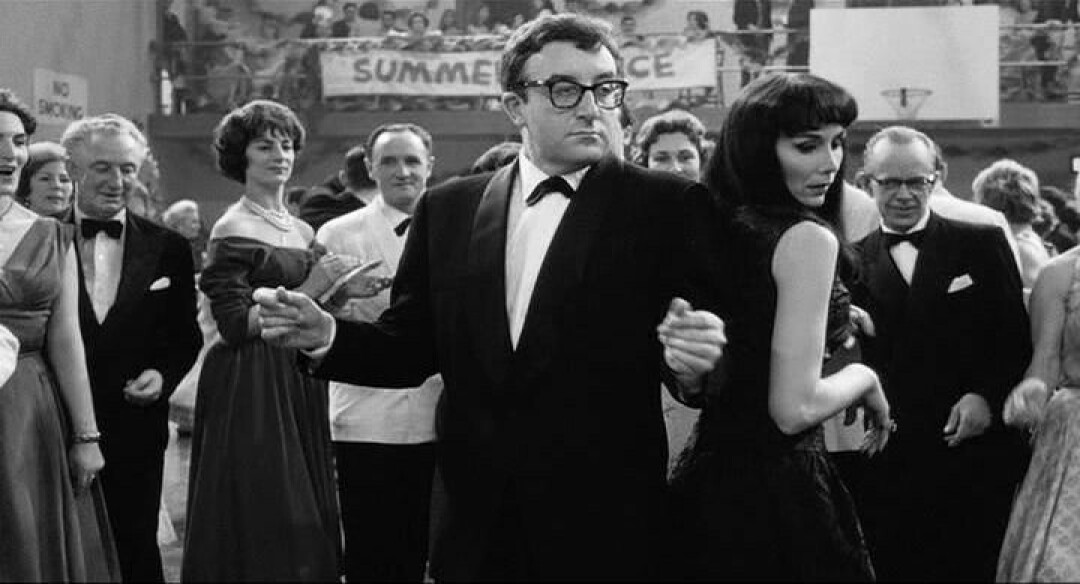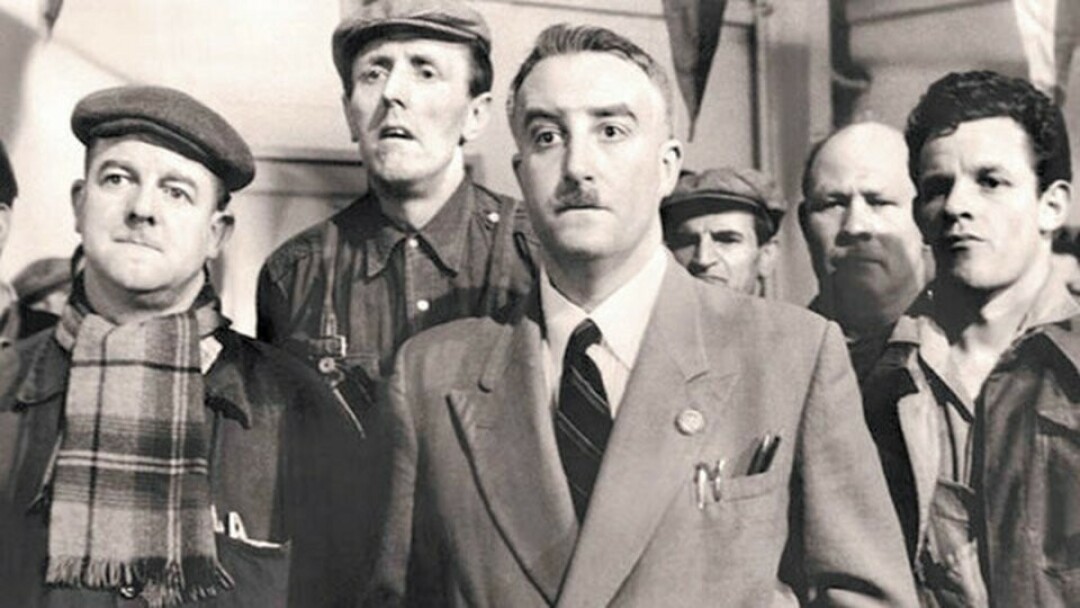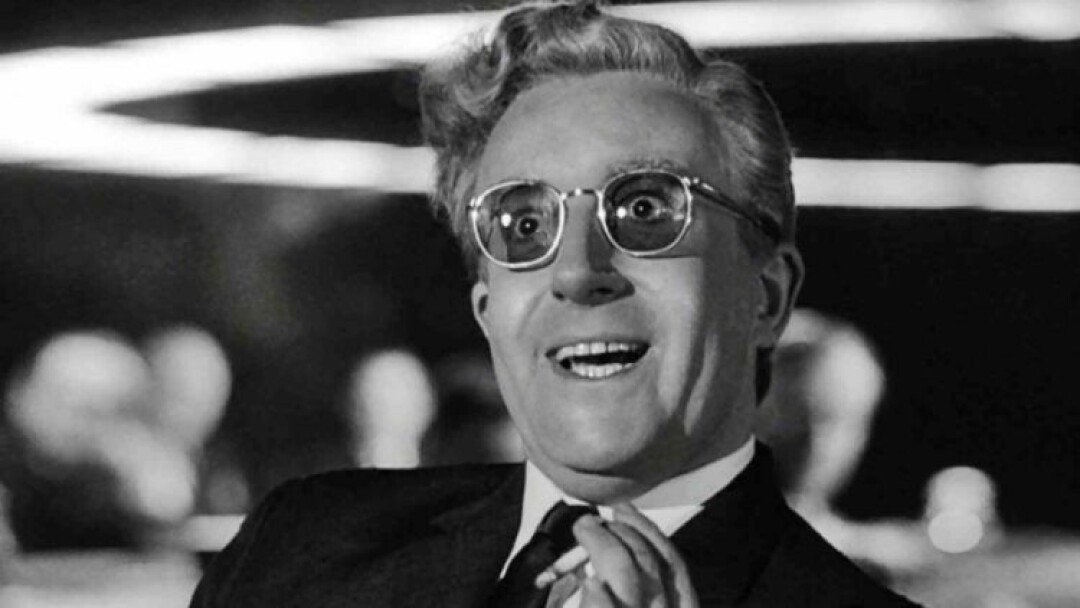The Ghost of Peter Sellers

Peter Sellers as Clare Quilty and Marianne Stone as his companion Vivian Darkbloom entertain the guests at a Ramsdale High School dance with a “beatnik” version of dancing, in Stanley Kubrick’s amazing 1962 film version of Vladimir Nabokov’s Lolita.
Peter Sellers was a chameleon.
From the early 1950s on, British radio and movie audiences heard and saw him perform in an astounding number of disguises, long before his comic genius was revealed to the larger world.
But, according to the new documentary The Ghost of Peter Sellers, he also was a deeply disturbed man – perhaps because of his chameleonic nature (Sellers once famously said he had no personality of his own).
Directed by prolific Hungarian-born filmmaker Peter Medak (The Ruling Class, The Changeling, Romeo Is Bleeding), it tells the story of trying to make a pirate movie in 1974 called Ghost in the Noonday Sun, starring Sellers and conceived of by his former Goon Show colleague Spike Milligan.
Despite the fact that everyone involved knew Sellers had almost immediately lost interest in the project and did his best to sabotage it, even faking a heart attack to leave the location to party in London, it was director Medak who has shouldered the blame for the failure all these years. He believes it hurt his career and, as it becomes obvious in the documentary, the failure haunts him to this day.

In short, we learn that despite the image Sellers put on the screen in so many great movies (and some not so great), Sellers was not an easy man to work with.
Apparently this was well known in the industry because at what appears to be a press conference in the documentary, Sellers says that he is not difficult, he just likes perfection, and not all directors are capable of that. He says that only a couple of them had the correct genius to direct him (he must certainly be referring to Stanley Kubrick as one of them – wish he would have named the other director).
To most Americans of a certain age, the comic genius of Peter Sellers was revealed in the almost back-to-back movies The Pink Panther (1963) and A Shot in the Dark (1964). The latter is the movie where Henry Mancini introduced the iconic Pink Panther theme song, with hard bop tenor saxophonist Plas John Johnson Jr. embedding the tune in so many young brains.
Brits, however, had a long history of Sellers going back to 1951 when he became a radio star as a member of the comedy troupe The Goons with Spike Milligan and Harry Secombe, as well as appearing in a wide variety of British TV and films, at first in supporting and then starring roles.
Growing up in Duluth, I became an Anglophile because WDIO would show classic British films late-night Thursdays – my mom’s bowling night – so I would stay up for them, devouring things such as the harrowing military movie Tunes of Glory and the serial killer tale Kind Hearts and Coronets, both featuring the also chameleonic Alec Guinness (he has nine roles in Kind Hearts).
Or things such as the Alexander Mackrendrick’s satire Whisky Galore and the 1962 British sci-fi thriller Day of the Triffids.
The only reason I can guess that WDIO – the new ABS affiliate in town at the time – was showing British films, well, the British invasion was happening, not just with music, but fashion and television, with shows such as The Avengers and The Saint and Secret Agent Man (later The Prisoner).
I was so swept up in the London Swings as a Pendulum Do thing that I eventually moved there, working my passage on a Norwegian tanker from Duluth to Liverpool, but that’s another story. This is just a set up for Peter Sellers.
I do believe I first saw him on WDIO in the 1955 black comedy The Ladykillers, a movie in which the two chameleons – Guinness and a young Sellers – work together as part of a band of bad guys planning a heist while posing as a string quintet to fool the old lady who has rented them a room to plot their.
I have to imagine that fellow Minnesotans the Coen Brothers also saw and were blown away by The Ladykillers when they were kids, hence their 2004 remake.
So, this is just by way of saying that I was already a Peter Sellers fan by the time The Pink Panther and the even more Clouseau-focused A Shot in the Dark came around. But those two movies certainly cemented for me the idea that Sellers was fun to watch. The bloom eventually wore off the Clouseau character during the six films he made in that franchise, but there were some great moments along the way.
As a longtime Sellers fan, I was quite happy to see the Criterion Channel release The Ghost of Peter Sellers, along with 11 Sellers’ films, including the 1961 Mr. Topaze, which I had never heard of before this, and, better yet, is directed by Sellers himself.
Mr. Topaze is a very odd film in the Sellers filmography. His character is an honest French schoolteacher who refuses to change the poor grades of a bratty boy with powerful connections. Because of his honesty, he is fired from teaching, but quickly learns he has a flair for capitalism.
Here is the full lineup:
Let’s Go Crazy: A 1951 short featuring variety acts and both Sellers and Spike Milligan in a variety of comic roles.
The Ladykillers: A 1955 caper comedy filled with dark humor and eccentric performances. Directed by the too-little known Alexander Mackendrick (Whisky Galore, The Man in the White Suit, Sweet Smell of Success).

Peter Sellers won a British best actor award for his role as uptight shop steward Fred Pike in the hilarious 1959 satiric look at English post-war class and capital, I’m All Right, Jack. Director Peter Medak claims in his documentary The Ghost of Peter Sellers that during filming of the failed 1974 pirate movie he was making with Sellers, the actor adopted his old role of Fred Pike in trying to foment labor troubles on the set.
I’m All Right, Jack: A 1959 Boulting Bros. production, also starring the great Terry Thomas as an exquisitely slimy personnel director. Sellers won a BAFTA for his role as the uptight labor boss who gets trapped in the scheming of his capitalist bosses.
The Mouse That Roared: A 1959 political satire with Sellers playing three roles – the inbred royal family of the tiny country of Grand Fenwick, which declares war on the U.S. as an economic strategy.
The Running Jumping Standing Still Film: A goofy short shot over two weekends for about 70 pounds by soon-to-be-famous director Richard Lester (A Hard Day’s Night). Spike Milligan joins Sellers for the mayhem.
Never Let Go: One of the several dramatic roles Sellers has in this lineup. In this 1960 British noir, hinged on the theft of a car, Sellers is the sadistic boss of a London car theft ring.
Mr. Topaze: This 1961 movie was directed by Sellers and he stars as well as the titular character, a French schoolteacher who loses his job for refusing to alter a grade.
Only Two Can Play: Sellers stars as a randy Welsh librarian. Though married, he sees himself as a player. His downfall comes through his second job as theater critic for the local newspaper. He tells his wife he is going to review a play, but leaves the play for a tryst. After his meeting with the also married woman, he turns in his review of the play that he didn’t see (written by his nemesis, a goateed poet played by Richard Attenborough). As he’s sitting at the breakfast table with wife and children, his wife alludes to his review of the play on the inside pages of the newspaper. However, on the front page is a story that the theater burned down before the play was acted. It’s an odd little movie that I enjoyed largely due to Sellers’ frustrated librarian.
Lolita: James Mason as pedophile Humbert Humbert and Peter Sellers as his nemesis, writer Clare Quilty. This 1962 film might be my favorite Kubrick movie, because of the performances of Sellers and Mason – oh, and Shelly Winters, too, as lonely widow Charlotte Haze, mother of the titular character, also well played by Sue Lyons.Kubrick apparently loved working with Sellers and once said of him, “He’s the only actor I know who can improvise.”

Dr. Strangelove, or: How I Learned to Stop Worrying and Love the Bomb: The funniest movie ever made about Cold War hysteria. Sellers is absolutely brilliant in all three roles – the crippled former Nazi Dr. Strangelove, U.S. President Merkin Muffley and British RAF officer Capt. Lionel Mandrake, who is assigned to Col. Jack Ripper (Sterling Hayden) on the very day Ripper decides it’s time to make war with the Commies. Mandrake might be my favorite Sellers character, and this, too, might be my favorite Kubrick movie.
The Optimists: Sellers in what may be the oddest role of his life, playing a former music hall performer who now gets by busking on the streets with his old dog Bella serving as the money collector. Two London urchins latch onto the old man, and they become an odd trio. The urban decay of inner city London of the early 1970s has never been on better display that it is in this 1973 film, directed by Anthony Simmons from his 1964 novel The Optimists of Nine elms. It was the only film appearance for either of the two child actors. The girl, Dona Mullane, was cast when the crew spotted her on the street. Her greatest dream is for her family to move from its present tenement to a tall, shiny block of flats across the Thames. But that does not happen.
